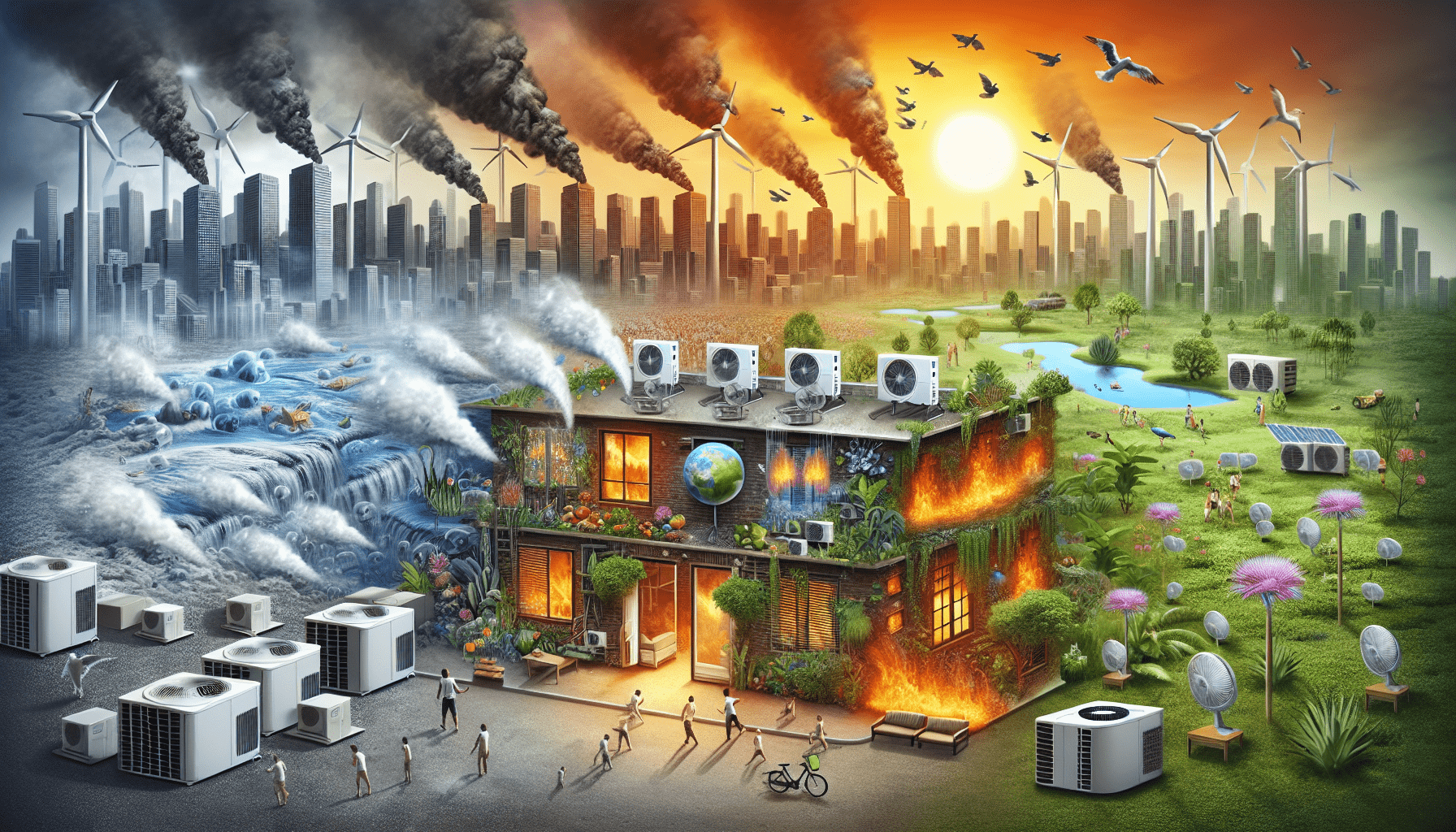Imagine living through a scorching summer without the blissful relief of air conditioning. It’s hard to fathom, isn’t it? Air conditioning has become an integral part of our lives, providing comfort and coolness during the hottest months. But have you ever wondered about its impact on the environment? This article explores the ins and outs of air conditioning and delves into the effects it has on our planet. From energy consumption to greenhouse gas emissions, we’ll uncover the truth behind the convenience we so often take for granted.
Energy Consumption
Energy consumption of air conditioning systems
Air conditioning systems are notorious for their high energy consumption. They require a significant amount of electricity to operate, leading to a strain on the energy grid. The cooling process depends on the compression and expansion of refrigerants, which consume a substantial amount of energy. As a result, air conditioning systems contribute to increased greenhouse gas emissions and global warming.
Increasing demand for air conditioning
The demand for air conditioning has been steadily increasing over the years. As temperatures rise due to climate change and economic development continues, more people are installing air conditioning units to combat the heat. This growing demand puts additional pressure on the energy sector and exacerbates the environmental impact of air conditioning systems.
Impact on greenhouse gas emissions
Air conditioning systems significantly contribute to greenhouse gas emissions, primarily through the generation of electricity required to power them. The reliance on fossil fuels for electricity production releases carbon dioxide (CO2) and other greenhouse gases into the atmosphere. These gases trap heat, leading to global warming and climate change. Therefore, the energy consumption of air conditioning systems has a direct and substantial impact on greenhouse gas emissions.
Ozone Depletion
Types of refrigerants used in air conditioning
Refrigerants play a crucial role in the cooling process of air conditioning systems. However, certain types of refrigerants, such as chlorofluorocarbons (CFCs) and hydrochlorofluorocarbons (HCFCs), have been identified as ozone-depleting substances. These refrigerants contain chlorine and bromine atoms that break down ozone molecules in the stratosphere, leading to ozone depletion.
Effects of refrigerants on the ozone layer
The depletion of the ozone layer has severe consequences for the environment and human health. Ozone depletion allows more ultraviolet (UV) radiation from the sun to reach the Earth’s surface, increasing the risk of skin cancer, cataracts, and other health issues. Moreover, higher UV radiation disrupts ecosystems, impacting crop yields, marine life, and overall biodiversity.
International efforts to reduce ozone depletion
To address the issue of ozone depletion, the international community came together and adopted the Montreal Protocol in 1987. This treaty aims to phase out the production and consumption of ozone-depleting substances, including certain refrigerants used in air conditioning systems. As a result of these global efforts, the ozone layer has shown signs of recovery, emphasizing the importance of international collaboration in protecting the environment.
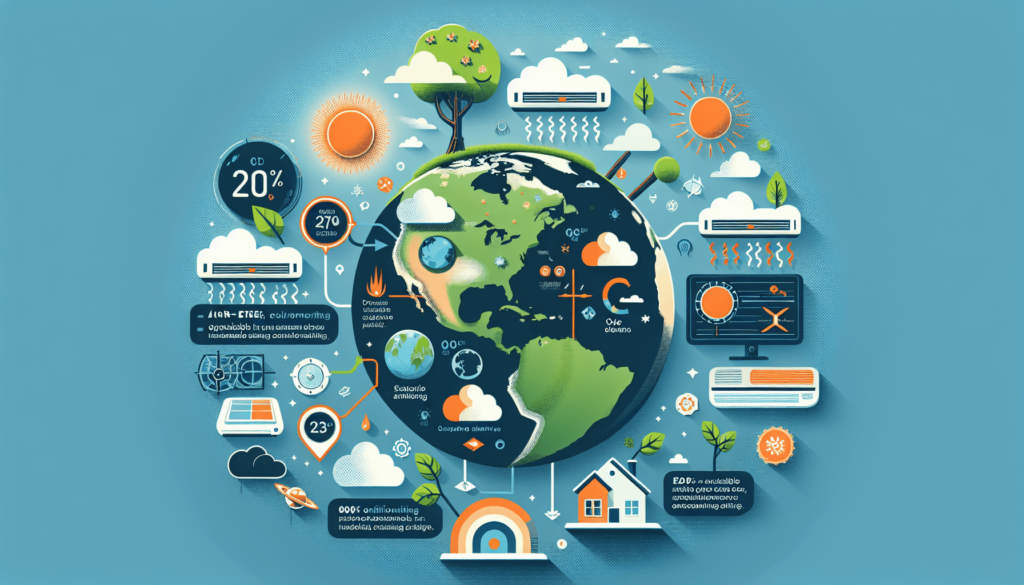
Indoor Air Quality
Air filtration and purification systems
Indoor air quality is a critical factor in maintaining a healthy and comfortable living or working environment. Air conditioning systems can contribute to improved indoor air quality through the use of air filtration and purification systems. These systems help remove pollutants, allergens, and contaminants from the air, ensuring a cleaner and healthier indoor environment.
Health effects of poor indoor air quality
Poor indoor air quality can have detrimental effects on human health. Exposure to indoor air pollutants can cause respiratory problems, allergies, asthma, and other respiratory illnesses. Individuals spending a significant amount of time in poorly ventilated spaces with limited access to fresh air are particularly susceptible to these health risks. Therefore, maintaining good indoor air quality is essential for promoting overall well-being.
Impacts on respiratory health
Air conditioning systems can impact respiratory health, particularly when not properly maintained or designed. Inadequate ventilation and poor humidity control can lead to the growth of mold and mildew, creating a breeding ground for allergens and irritants. Additionally, air conditioning systems that recirculate indoor air without filtration can spread airborne pollutants, including dust, pollen, and pet dander, exacerbating respiratory conditions and reducing overall lung function.
Heat Island Effect
Definition and causes of the heat island effect
The heat island effect refers to the phenomenon where urban areas experience higher temperatures than surrounding rural areas due to human activities and modifications to the landscape. As cities expand and replace natural surfaces with buildings, roads, and parking lots, these surfaces absorb and retain more heat from the sun, leading to elevated temperatures in urban areas.
Contribution of air conditioning to the heat island effect
Air conditioning systems can contribute to the heat island effect in several ways. The electricity required to power air conditioning units adds to the overall heat generated within urban areas. Additionally, waste heat from air conditioning units released into the outdoor environment further increases the ambient temperature. As a result, the use of air conditioning systems in urban areas can intensify the heat island effect and its associated challenges.
Urban planning strategies to mitigate the heat island effect
To mitigate the heat island effect, urban planners and designers are implementing various strategies. These include increasing green spaces, such as parks and rooftop gardens, to absorb heat and provide shade. Additionally, the use of cool roofs and pavements that reflect sunlight instead of absorbing it can help reduce surface temperatures. Effective urban planning can promote natural cooling and contribute to more sustainable and comfortable cities.
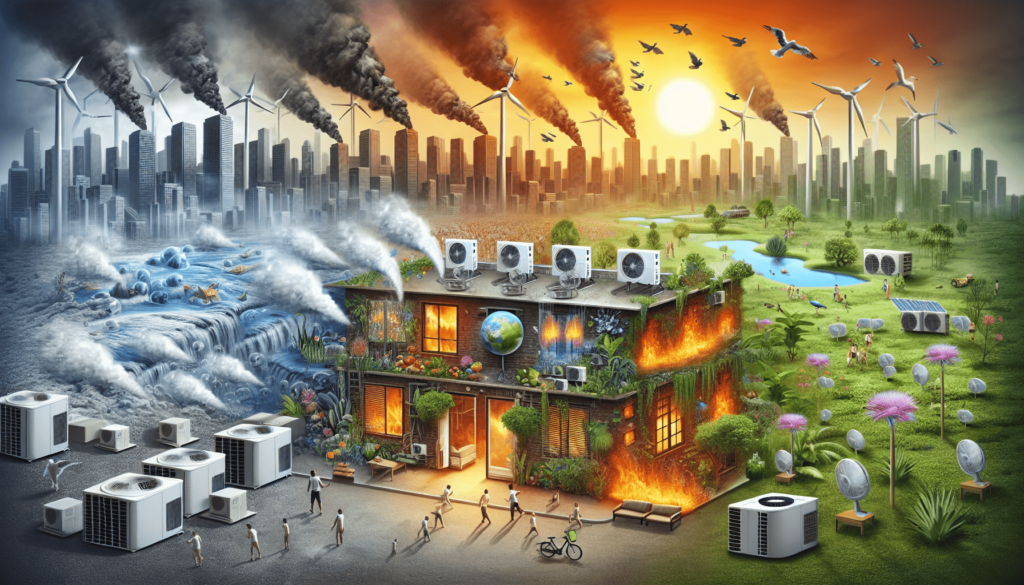
Water Consumption
Water requirements for air conditioning systems
Air conditioning systems require water for various purposes, such as cooling towers and condenser units. These systems consume a significant amount of water during operation, putting a strain on water resources. In areas with limited water availability or facing drought conditions, the high water consumption of air conditioning systems can exacerbate water scarcity issues.
Impact on water resources and freshwater ecosystems
The excessive water consumption by air conditioning systems can have profound impacts on both water resources and freshwater ecosystems. Drawing large amounts of water from rivers, lakes, or underground sources can deplete water reserves, leading to reduced water availability for ecosystems and human consumption. Moreover, the discharge of warm water back into water bodies can disrupt aquatic ecosystems, affecting the health and survival of aquatic flora and fauna.
Water-efficient alternatives and technologies
To address the water consumption associated with air conditioning systems, water-efficient alternatives and technologies are being developed. These include the use of evaporative coolers, which rely on the natural evaporation of water to cool indoor spaces. Additionally, advancements in cooling tower designs and systems that recycle and reuse water can significantly reduce water consumption, promoting more sustainable cooling solutions.
Waste Generation
Disposal of old or inefficient air conditioning units
The disposal of old or inefficient air conditioning units poses environmental challenges. These units often contain hazardous components, including refrigerants and PCBs, which can contaminate soil and water if not properly handled. Moreover, improper disposal can result in electronic waste ending up in landfills, contributing to pollution and the release of harmful substances into the environment.
Electronic waste and its environmental impact
Electronic waste, including discarded air conditioning units, has substantial environmental impacts. When improperly disposed of, electronic waste releases toxic substances such as lead, mercury, and cadmium into the environment, posing risks to human health and ecosystems. Furthermore, the extraction of raw materials and energy-intensive production processes associated with manufacturing new air conditioning units contribute to additional environmental degradation.
Recycling and proper disposal practices
To mitigate the negative impacts of waste generation from air conditioning units, recycling and proper disposal practices are essential. Recycling facilities can recover valuable materials from old units, reducing the need for new resource extraction. Additionally, proper disposal procedures, such as safely handling refrigerants and dismantling units to separate hazardous components, help prevent environmental contamination and promote the circular economy.
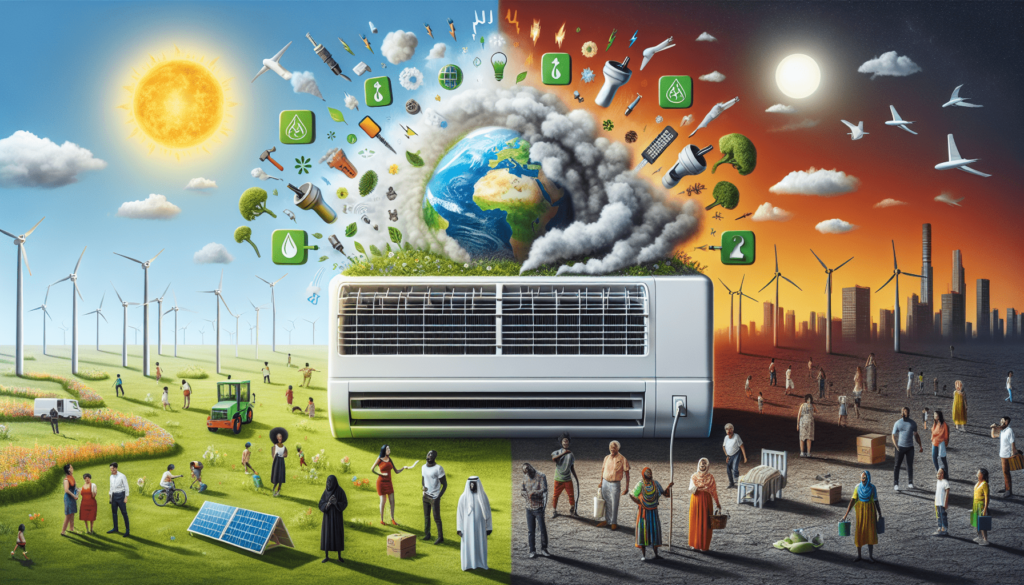
Climate Change
Contribution to global warming
Air conditioning systems play a significant role in contributing to global warming. The energy consumption required to power these systems often relies on fossil fuel combustion, releasing greenhouse gases such as carbon dioxide (CO2), methane (CH4), and nitrous oxide (N2O). These gases trap heat in the atmosphere, leading to increased global temperatures and climate change.
Role in exacerbating heat waves
As global temperatures continue to rise, the demand for air conditioning increases to combat extreme heat events. Paradoxically, the increased use of air conditioning can contribute to the exacerbation of heat waves. The release of waste heat from air conditioning units into the outdoor environment can further warm urban areas, intensifying the heat island effect and creating a cycle of increasing energy consumption and temperature rise.
Adaptation and mitigation strategies
To address the environmental impact of air conditioning systems on climate change, both adaptation and mitigation strategies are necessary. Adapting to climate change involves designing buildings with natural ventilation and passive cooling techniques that reduce reliance on air conditioning. Mitigation involves promoting energy-efficient air conditioning units, transitioning to renewable energy sources, and implementing policies to reduce greenhouse gas emissions from the energy sector.
Renewable Energy Integration
Opportunities for using renewable energy in air conditioning
Integrating renewable energy sources into air conditioning systems presents significant opportunities for reducing environmental impact. Solar energy, for example, can be harnessed to power air conditioning units directly or contribute to electricity generation. Wind energy and geothermal energy are also viable options for powering air conditioning systems with renewable sources, reducing reliance on fossil fuels and mitigating greenhouse gas emissions.
Advantages and challenges of renewable energy integration
The integration of renewable energy into air conditioning systems offers several advantages. Firstly, it reduces the carbon footprint associated with energy consumption, diminishing the environmental impact. Secondly, renewable energy sources are often decentralized, allowing for greater energy independence and resilience. However, challenges such as intermittency, cost, and infrastructure development must be overcome to fully harness the potential of renewable energy integration in air conditioning.
Promoting sustainable cooling solutions
Promoting sustainable cooling solutions requires a multi-faceted approach. Governments, policymakers, and businesses can incentivize the adoption of energy-efficient air conditioning units and create financial incentives for renewable energy integration. Education and awareness campaigns can inform consumers about the environmental impact of air conditioning and encourage eco-conscious choices. By embracing sustainable cooling solutions, we can reduce the environmental footprint of air conditioning while ensuring a comfortable living and working environment.
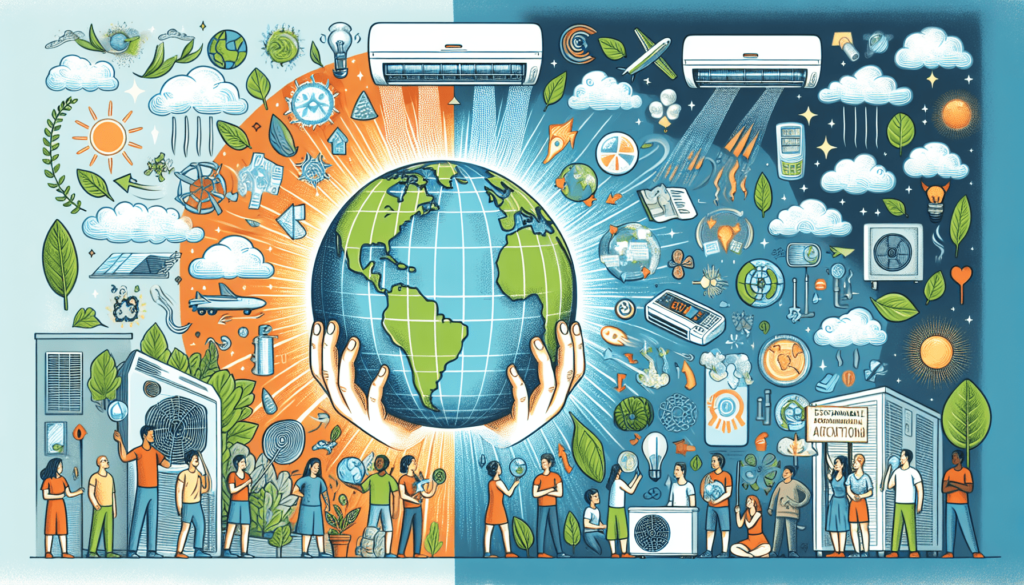
Architectural Design
Building orientation and passive cooling techniques
Architectural design plays a crucial role in minimizing the environmental impact of air conditioning. Building orientation can optimize natural light and airflow, reducing the need for artificial lighting and mechanical cooling. Passive cooling techniques, such as the use of shading devices, insulation, and natural ventilation, can effectively maintain comfortable indoor temperatures without excessive reliance on air conditioning systems.
Use of natural ventilation and shading
Natural ventilation and shading are sustainable design strategies that prioritize the use of outdoor air and reduce solar heat gain. Properly placed windows, skylights, and louvers can facilitate the flow of fresh air, reducing the need for mechanical ventilation. Shading devices, such as awnings, trees, and exterior fins, can block direct sunlight, preventing excessive heat gain and reducing the cooling load on air conditioning systems.
Design considerations for energy-efficient buildings
Energy-efficient building design requires careful consideration of multiple factors. Insulation materials and techniques can minimize heat transfer through walls, roofs, and windows, improving energy efficiency. High-performance glazing, such as low-emissivity glass, can reduce heat gain while still allowing natural light. Additionally, the use of smart building technologies, such as occupancy sensors and automated energy management systems, can optimize energy consumption and improve overall building efficiency.
Behavioral Changes
Setting appropriate temperature and humidity levels
Individuals can contribute to minimizing the environmental impact of air conditioning through behavioral changes. Setting appropriate temperature and humidity levels can help reduce energy consumption. By raising the thermostat a few degrees in the summer or using programmable thermostats, you can decrease the load on air conditioning systems. Similarly, adjusting humidity levels within the recommended range can enhance comfort without excessive reliance on energy-intensive dehumidification.
Efficient use of air conditioning systems
Efficient use of air conditioning systems involves adopting practices that maximize energy conservation. Simple measures such as closing windows and doors while using air conditioning, ensuring proper insulation, and properly maintaining and cleaning air filters can optimize system performance. Additionally, using fans in conjunction with air conditioning units can create a more comfortable environment while reducing the need for lower thermostat settings.
Promoting eco-conscious habits
Promoting eco-conscious habits at the individual, community, and organizational levels is instrumental in mitigating the environmental impact of air conditioning. Educating individuals about energy conservation techniques, such as using natural ventilation whenever possible, encouraging the use of energy-efficient appliances, and promoting the benefits of sustainable cooling solutions can foster a culture of environmental responsibility. By making conscious choices and adopting eco-friendly practices, we can collectively reduce the environmental footprint of air conditioning.

